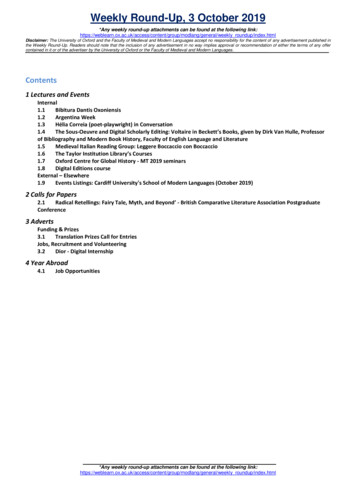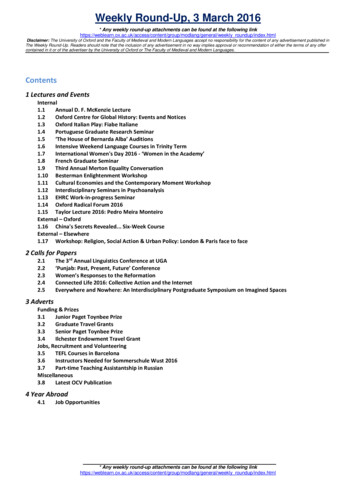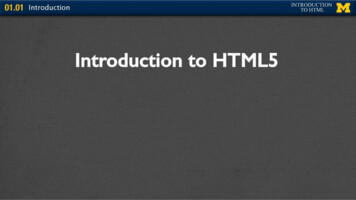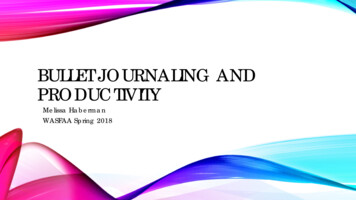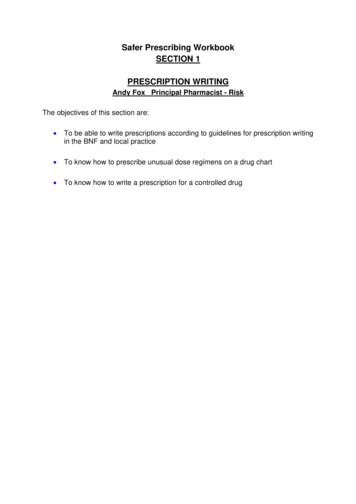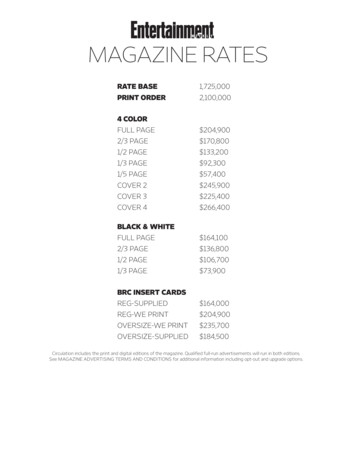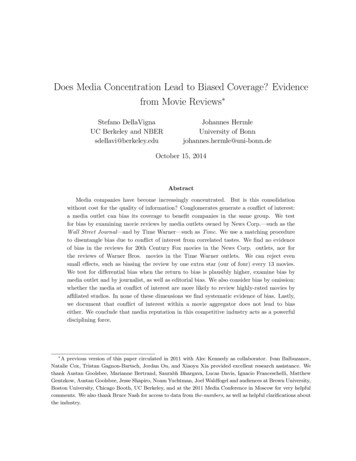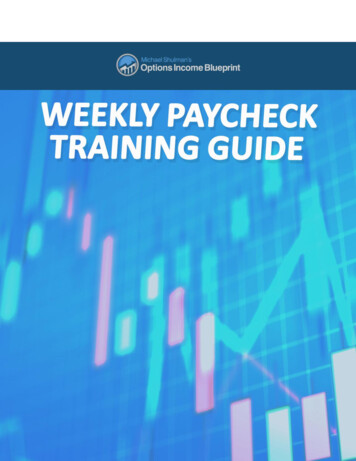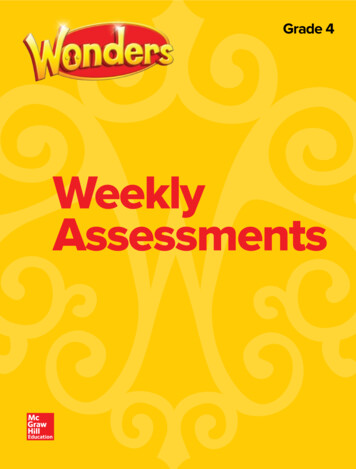
Transcription
Grade 4WeeklyAssessments
Grade 4WeeklyAssessments
www.mheonline.com/readingwondersCopyright McGraw-Hill EducationAll rights reserved. The contents, or parts thereof, may bereproduced in print form for non-profit educational usewith Reading Wonders provided such reproductions bearcopyright notice, but may not be reproduced in any form forany other purpose without the prior written consent ofMcGraw-Hill Education, including, but not limited to, networkstorage or transmission, or broadcast for distance learning.Send all inquiries to:McGraw-Hill EducationTwo Penn PlazaNew York, New York 10121ISBN: 978-0-07-680141-1MHID: 0-07-680141-1Printed in the United States of America.4 5 6 7 8 9 RHR 21 20 19 18 17 16D
Table of ContentsTeacher Introduction .vUnit 1Week 1 Assessment .1Week 2 Assessment . 13Week 3 Assessment . 25Week 4 Assessment . 37Week 5 Assessment . 49Unit 2Week 1 Assessment . 61Week 2 Assessment . 73Week 3 Assessment . 85Week 4 Assessment . 97Week 5 Assessment . 109Unit 3Week 1 Assessment . 121Copyright McGraw-Hill EducationWeek 2 Assessment . 133Week 3 Assessment . 145Week 4 Assessment . 157Week 5 Assessment . 169
Table of Contents– Cont’d.Unit 4Week 1 Assessment . 181Week 2 Assessment . 193Week 3 Assessment . 205Week 4 Assessment . 217Week 5 Assessment . 229Unit 5Week 1 Assessment . 241Week 2 Assessment . 253Week 3 Assessment . 265Week 4 Assessment . 277Week 5 Assessment . 289Unit 6Week 1 Assessment . 301Week 2 Assessment . 313Week 3 Assessment . 325Week 5 Assessment . 349Copyright McGraw-Hill EducationWeek 4 Assessment . 337
Teacher IntroductionWeekly AssessmentsThe Weekly Assessments component is an integral part of the complete assessmentprogram aligned with Reading Wonders and state standards.Purpose of Weekly AssessmentsWeekly Assessments offers the opportunity to monitor student progress in a steady andstructured manner while providing formative assessment data. As students completeeach week of the reading program, they will be assessed on their understanding of keyinstructional content. The results of the assessments can be used to inform subsequentinstruction.The results of Weekly Assessments provide a status of current achievement in relation tostudent progress through the curriculum.Focus of Weekly AssessmentsThe focus of Weekly Assessments is on two key areas of English Language Arts—Readingand Language. Students will read two selections each week and respond to items focusingon Comprehension Skills and Vocabulary Strategies. These items assess the ability toaccess meaning from the text and demonstrate understanding of unknown and multiplemeaning words and phrases.Copyright McGraw-Hill EducationAdministering Weekly AssessmentsEach weekly assessment should be administered once the instruction for the specific weekis completed. Make copies of the weekly assessment for the class. You will need one copyof the Answer Key page for each student taking the assessment. The scoring table at thebottom of the Answer Key provides a place to list student scores. The accumulated datafrom each weekly assessment charts student progress and underscores strengths andweaknesses.After each student has a copy of the assessment, provide a version of the followingdirections: Say: Write your name and the date on the question pages for this assessment.(When students are finished, continue with the directions.) You will read two selectionsand answer questions about them. Read each selection and the questions that follow itcarefully. For the multiple-choice items, completely fill in the circle next to the correctanswer. For items that require a written response, write that response clearly in the spaceprovided. For the constructed response item, write your response on the lines provided.When you have completed the assessment, put your pencil down and turn the pagesover. You may begin now.Answer procedural questions during the assessment, but do not provide any assistanceon the items or selections. After the class has completed the assessment, ask students toverify that their names and the date are written on the necessary pages.Weekly Assessment Teacher Introductionv
Teacher IntroductionOverview of Weekly AssessmentsEach weekly assessment is comprised of the following 2 “Cold Read” selections 10 items assessing Comprehension Skills and Vocabulary Strategies 1 constructed response item assessing Comprehension and the ability to write across textsReading SelectionsEach weekly assessment features two selections on which the assessment items arebased. (In instances where poetry is used, multiple poems may be set as a selection.) Theselections reflect the unit theme and/or weekly Essential Question to support the focus ofthe classroom instruction. Because the weekly assessments have been composed to assessstudent application of the skills rather than genre or genre knowledge, selections are notalways the same genre as the reading selections in the Literature Anthology or RWW.Selections increase in complexity as the school year progresses to mirror the rigor ofreading materials students encounter in the classroom. The Lexile goal by unit is as follows––Unit 1: 740L; Unit 2: 780L; Unit 3: 820L; Unit 4: 860L; Unit 5: 900L; and Unit 6: 940L.Assessment ItemsWeekly assessments feature the following item types––selected response (SR), multipleselected response (MSR), evidence-based selected response (EBSR), constructed response(CR), technology-enhanced constructed response (TECR), and extended constructedresponse (ECR). (Please note that the print versions of TECR items are available inthis component; the full functionality of the items is available only through the onlineassessment.) This variety of item types provides multiple methods of assessing studentunderstanding, allows for deeper investigation into skills and strategies, and providesstudents an opportunity to become familiar with the kinds of questions they will encounterin next generation assessments, both consortia-related and state-mandated.Comprehension ItemsVocabulary ItemsEach selection is followed by items that ask students to demonstrate the ability to uncoverthe meanings of unknown and multiple-meaning words and phrases using VocabularyStrategies.Comprehension—Extended Constructed ResponseAt the close of each weekly assessment is a constructed response item that provides studentsthe opportunity to craft a written response that shows their critical thinking skills and allowsthem to support an opinion/position by using text evidence from one or both selections.NOTE: Please consider this item as an optional assessment that allows students to showcomprehension of a text in a more in-depth manner as they make connections betweenand within texts.viWeekly Assessment Teacher IntroductionCopyright McGraw-Hill EducationEach selection is followed by items that assess student understanding of the text throughthe use of Comprehension Skills—both that week’s Comprehension Skill focus and a reviewComprehension Skill. The review skill is taken from a week as near as possible to thecurrent week and aligns with the instruction.
Teacher IntroductionScoring Weekly AssessmentsItems 1–10 are each worth two points, for a twenty-point assessment. Each part of aEBSR is worth 1 point; MSR and TECR items should be answered correctly in full, thoughyou may choose to provide partial credit. If you decide to have students complete theconstructed response, use the correct response parameters provided in the Answer Keyalong with the scoring rubric listed below to assign a score of 0 through 4.Score: 4 The student understands the question/prompt and responds suitably using the appropriate text evidence from the selection or selections.The response is an acceptably complete answer to the question/prompt.The organization of the response is meaningful.The response stays on-topic; ideas are linked to one another with effective transitions.The response has correct spelling, grammar, usage, and mechanics, and it is writtenneatly and legibly.Score: 3 The student understands the question/prompt and responds suitably using the appropriate text evidence from the selection or selections.The response is a somewhat complete answer to the question/prompt.The organization of the response is somewhat meaningful.The response maintains focus; ideas are linked to one another.The response has occasional errors in spelling, grammar, usage, and mechanics, and itis, for the most part, written neatly and legibly.Score: 2Copyright McGraw-Hill Education The student has partial understanding of the question/prompt and uses some text evidence.The response is an incomplete answer to the question/prompt.The organization of the response is weak.The writing is careless; contains extraneous information and ineffective transitions.The response requires effort to read easily.The response has noticeable errors in spelling, grammar, usage, and mechanics, and itis written somewhat neatly and legibly.Score: 1 The student has minimal understanding of the question/prompt and uses little to no appropriate text evidence.The response is a barely acceptable answer to the question/prompt.The response lacks organization.The writing is erratic with little focus; ideas are not connected to each other.The response is difficult to follow.The response has frequent errors in spelling, grammar, usage, and mechanics, and it iswritten with borderline neatness and legibility.Score: 0 The student fails to compose a response. If a response is attempted, it is inaccurate, meaningless, or completely irrelevant. The response may be written so poorly that it is neither legible nor understandable.Weekly Assessment Teacher Introductionvii
Teacher IntroductionEvaluating ScoresThe primary focus of each weekly assessment is to evaluate student progress towardmastery of previously-taught skills and strategies.The expectation is for students to score 80% or higher on the assessment as a whole.Within this score, the expectation is for students to score 75% or higher on the itemsassessing Comprehension Skills; score 75% or higher on the items assessing the particularweek’s Vocabulary Strategy; and “3” or higher on the extended constructed response,if assigned.For students who do not meet these benchmarks, assign appropriate lessons from theTier 2 online PDFs. Refer to the weekly “Progress Monitoring” spreads in the Teacher’sEditions of Wonders for specific lessons.The Answer Keys in Weekly Assessments have been constructed to provide theinformation you need to aid your understanding of student performance, as well asindividualized instructional and intervention needs. Further metadata is available in theonline versions of the assessment, including specific test claims and targets.This column lists the instructional contentfor the week that is assessed in each item.Question CorrectAnswerContent FocusCCSSThis column lists alignment foreach assessment item.ComplexityThis column lists the Depth of Knowledgeassociated with each item.B, EMain Idea and Key DetailsRI.4.2DOK 28DContext CluesL.4.4aDOK 29ACMain Idea and Key DetailsRI.4.2DOK 29BBMain Idea and Key Details/Text EvidenceRI.4.2/RI.4.1DOK 2Although all items feature use of text evidence,this is explicitly mentioned in PART B EBSR items.Comprehension 1A, 1B, 4, 5, 6, 7A, 7B, 10/12%Vocabulary 2, 3A, 3B, 8, 9/8%Total Weekly Assessment Score/20%Scoring rows identify items associatedwith Reading and Language strandsand allow for quick record keeping.viiiWeekly Assessment Teacher IntroductionCopyright McGraw-Hill Education7
UNIT 1 WEEK 1Read the passage “The Robin and the Vase” before answering Numbers 1through 5.The Robin and the VaseBased on “The Crow and the Pitcher” from Aesop’s FablesA robin was flying south for the winter, and during his flight, he becamethirsty. He knew that without water he would be too weak to continue hisjourney. He looked for a place to rest that was near water, but he did not seea drop anywhere.Just when the robin was about to abandon all hope, he spotted a containeron a picnic table. He was glad he had not given up trying to find water. Thetall, thin vase was exactly what he needed. He landed on a tree branch nearthe table. “I know what that is used for!” the robin squawked excitedly. “I’veseen people put flowers in these containers. Flowers need water. Maybethere is some water left in the bottom.”The robin flew quickly to the vase and perched on its edge. He saw thatthere was some water inside. Finally, he was relieved that he would be ableto drink some water and quench his thirst. He was so grateful. Then helowered his head and put his beak inside the vase.The robin’s joy quickly turned to despair when he discovered that his beakwas not long enough to reach the water. Realizing the vase was too tall andnarrow, the robin cried, “Now what am I going to do?”Copyright McGraw-Hill EducationAs the robin perched on the edge of the vase, he thought about his problem.He needed water to stay alive. “My survival depends on getting water fromthis vase!” he shouted.GO ONWeekly Assessment Unit 1, Week 1Grade 41
UNIT 1 WEEK 1The water was so close yet so very far away. He could clearly see the liquid,but he could not get close enough to drink it. Somehow, he needed to raisethe water. But how? Suddenly, the robin got an idea.After looking around the yard, the robin spied a statue sitting among manysmall stones. He thought that if he could drop stones into the vase, the waterlevel would rise.So the robin flew toward the stones. He used his beak to pick up two smallstones and then flew back to the vase. After dropping a few more stonesinto the vase he saw that the water was a little higher. This spurred him onand he felt hopeful. He kept telling himself, “You can do this!” The robinflew back and forth between the stones and the vase. Each time, he droppeda few small stones in the vase and watched as the water rose.Finally the vase was full of stones, and the water was at the top. The robintook a long drink of water and satisfied his thirst. He was proud of himselffor having such a clever idea.Copyright McGraw-Hill EducationGO ON2Grade 4Weekly Assessment Unit 1, Week 1
Name:Date:Now answer Numbers 1 through 5. Base your answers on “The Robin andthe Vase.”1This question has two parts. First, answer part A. Then, answer part B.Part A: Read the following sentences from the passage.Just when the robin was about to abandon all hope, he spotted acontainer on a picnic table. He was glad he had not given up trying tofind water. Which word means almost the same as abandon in the sentencesabove?A findB gainC quitDspot Part B: Which words from the sentences help the reader understandthe meaning of abandon?A “spotted a container”B“given up trying”C “was glad”Copyright McGraw-Hill EducationD“trying to find”2 What happens after the robin gets thirsty but before he collects thestones? Pick two choices.A The robin sees a vase.BThe robin gets a drink of water.C The robin puts stones in the vase.DThe robin watches the water rise.EThe robin has an idea.GO ONWeekly Assessment Unit 1, Week 1Grade 43
Name:3Date:Read the following sentence from the passage.The robin’s joy quickly turned to despair when he discovered that hisbeak was not long enough to reach the water.Which word means almost the same as despair?A angerBfearlessnessC hopelessnessDjoy4 Mark the boxes in order of the sequence of events. Some columns mayhave more than one selection.This happenedfirst.This happenednext.This happenedlast.The robin’shope faded.The robin wasproud ofhimself.The robinlooked for aplace to rest.Copyright McGraw-Hill EducationThe robindropped thestones in thevase.GO ON4Grade 4 Weekly Assessment Unit 1, Week 1
Name:5Date:This question has two parts. First, answer part A. Then, answer part B.Part A: Which event happens last in the passage?A The robin is grateful to find water.BThe robin drinks from the vase.C The robin spots a container.DThe robin thinks of a plan. Part B: Which word lets the reader know this is the last event in thepassage?A cleverBfinallyC proudwaterCopyright McGraw-Hill EducationDGO ONWeekly Assessment Unit 1, Week 1Grade 45
UNIT 1 WEEK 1Read the passage “What Did She Want?” before answering Numbers 6through 10.What Did She Want?Dan studied the tracks on the ground. For the third night in a row, the adultbear had returned to visit the pen. Was she here because she was lookingfor food? Or was she here because of the cub locked in the pen? If that wasthe reason, what did she want with the little bear?Dan thought about the cub. He knew there was a lot the cub could learnfrom an adult bear. He didn’t want to interfere with the bears getting toknow each other, and he was afraid to disturb a meeting between the adultbear and the cub. After all, the cub had been brought to him injured. As thecub’s guardian, Dan had a responsibility to make sure it was safe. It waspossible that the cub had been hurt by the adult bear. On the other hand,what if the adult bear was friendly? She could teach the cub things it had tolearn so it could survive in the wilderness. Dan decided it was worth takinga chance. He would let the adult bear near the cub. But he had an ideaabout how to protect himself, just in case this turned out to be a mistake.Copyright McGraw-Hill EducationGO ON6Grade 4Weekly Assessment Unit 1, Week 1
UNIT 1 WEEK 1That night, Dan waited in the shadows near the pen with a big flashlight inhis hand. If the adult bear tried to hurt the cub, he would try to scare her offwith the light. If that did not work, he also had a loud horn with him. Hethought the sudden noise from the horn would frighten the adult and driveher away.Dan did not have to wait very long, because soon there was a rustling inthe woods. Then the adult proclaimed her presence with a low growl. Asshe emerged from behind a tree, Dan saw that she was strong and healthy.Worried that he had made the wrong decision, he hoped she wouldscare easily.As soon as the cub heard her growl, it perked up and started toward thefence in an awkward run. When the two bears met at the fence, the adultstood and put her front paws against it. The cub tried to do the same, buttottered and fell forward. The adult bear snorted, and Dan was not surewhat the snort meant. Then the cub stuck its nose through the fence in afriendly greeting. How would the adult bear respond? Dan’s heart raced ashe raised the flashlight and the horn, ready to act.Copyright McGraw-Hill EducationThe adult bear leaned forward and gently rubbed her nose against thecub’s nose. Dan lowered the flashlight and released his grip on the horn.Everything was going to be just fine.GO ONWeekly Assessment Unit 1, Week 1Grade 47
Name:Date:Now answer Numbers 6 through 10. Base your answers on “What DidShe Want?”6 Which events most likely happened before the passage takes place?Pick two choices.A The adult bear visits the cub.BThe adult bear scares Dan.C The cub is put in a pen.7DThe cub leaves tracks.EThe cub leaves with the adult bear.Read the following sentences from the passage.He knew there was a lot the cub could learn from an adult bear. Hedidn’t want to interfere with the bears getting to know each other, andhe was afraid to disturb a meeting between the adult bear and the cub. Which word from the sentences has almost the same meaningas interfere?A learnBwantC knowDdisturbCopyright McGraw-Hill EducationGO ON8Grade 4 Weekly Assessment Unit 1, Week 1
Name:8Date:This question has two parts. First, answer part A. Then, answer part B.Part A: Read the following sentences from the passage.After all, the cub had been brought to him injured. As the cub’sguardian, Dan had a responsibility to make sure it was safe. It waspossible that the cub had been hurt by the adult bear.Which word could the author use instead of guardian?A doctorBpredatorC protectorDteacherPart B: Which phrase supports your answer in part A?A “brought to him injured”B“had a responsibility”C “had been hurt”“was possible”Copyright McGraw-Hill EducationDGO ONWeekly Assessment Unit 1, Week 1Grade 49
Name:9Date:What happens at the end of the passage?A The adult bear tracks are seen by Dan.BDan realizes that everything is fine.C The cub is brought to Dan.D10Dan comes up with a plan.Place the events into the correct sequence. Write 1 next to the firstevent and 2–6 next to the other events based on the sequence.Dan comes up with a plan.The cub is brought to Dan.The adult bear growls.Dan waits for the adult bear to return.Dan wonders what the adult bear wants.The bears rub noses.10Grade 4Weekly Assessment Unit 1, Week 1Copyright McGraw-Hill EducationSTOP
Name:Date:Now answer Number 11. Base your answer on “The Robin and the Vase”and “What Did She Want?”Explain how clever ideas help characters solve problems in thepassages “The Robin and the Vase” and “What Did She Want?”Support your answer with clear text evidence from the passages.Copyright McGraw-Hill Education11Weekly Assessment Unit 1, Week 1Grade 411
Answer KeyQuestionCorrectAnswerContent FocusCCSSComplexity1ACContext Clues: SynonymsL.4.5cDOK 21BBContext Clues: Synonyms/Text EvidenceL.4.5c/RL.4.1DOK 22A, ECharacter, Setting, Plot: SequenceRL.4.3DOK 13CContext Clues: SynonymsL.4.5cDOK 24see belowCharacter, Setting, Plot: SequenceRL.4.3DOK 15ABContext Clues: SynonymsL.4.5cDOK 25BBContext Clues: Synonyms/Text EvidenceL.4.5c/RL.4.1DOK 26A, CCharacter, Setting, Plot: SequenceRL.4.3DOK 17DContext Clues: SynonymsL.4.5cDOK 28ACContext Clues: SynonymsL.4.5cDOK 28BBContext Clues: Synonyms/Text EvidenceL.4.5c/RL.4.1DOK 29BCharacter, Setting, Plot: SequenceRL.4.3DOK 110see belowCharacter, Setting, Plot: SequenceRL.4.3DOK 111see belowWriting About TextW.4.9aDOK 4Comprehension 2, 4, 6, 9, 10/10%Vocabulary 1A, 1B, 3, 5A, 5B, 7, 8A, 8B/10%Total Weekly Assessment Score/20%Students should complete the chart with the following sequence: The robin looked for a place to rest. The robin’s hope faded. The robin dropped the stones in the vase. The robin was proud of himself.10Students place the items into the following sequence: The cub is brought to Dan. Dan wonders what the adult bear wants. Dan comes up with a plan. Dan waits for the adult bear to return. The adult bear growls. The bears rub noses. The following information should be included: The robin figured out how to get the water itneeded to drink. Dan came prepared to protect himself and the cub. Some students mightmake the connection that both sets of clever ideas provided a means for survival.Grade 4 Weekly Assessment Unit 1, Week 1Copyright McGraw-Hill Education41112Name:
UNIT 1 WEEK 2Read the passage “One Act of Kindness” before answeringNumbers 1 through 5.One Act of KindnessIt was a bright, sunny Saturday morning, and the local grocery store wasbusy with many customers. The store manager was preparing for the daywhen she looked up from the service desk where she was working. Shenoticed a young boy was struggling to push his grandmother’s wheelchairthrough the doors. The manager rushed over to give him a hand.“Here,” she said with a smile. “Let me help you with that.” The managerhelped the boy push the wheelchair through the door and into the store.“Thank you for helping me,” the boy said gratefully. He smiled as he turnedand continued to push the wheelchair into the store. They passed a manreading the label on a box of cereal. While the man’s back was turned, hisgroceries suddenly began tumbling from his cart.Copyright McGraw-Hill Education“Oh, no!” the man exclaimed frowning at the groceries on the floor. “NowI’m in a pickle and I have quite a mess to clean up here!” There were cansand boxes lying all over the grocery aisle.“Here,” the boy saidwith a smile. “Let mehelp you pick upthose groceries.”Together they beganpicking up the fallenitems and reloadedthem back into theshopping cart.GO ONWeekly Assessment Unit 1, Week 2Grade 413
UNIT 1 WEEK 2“Thank you, you are very thoughtful to stop and help me,” the man said,grateful for the boy’s help.The boy grinned and thought, “Helping others sure is a piece of cake!”The man beamed and turned away from the boy and his grandmother. Theman walked to the checkout lanes, and he arrived at the same time as awoman. He noticed that she had only a few items in her basket, while hehad many, many items in his cart.“You can go ahead of me,” the man said to the woman. “You only have twoitems, so you’ll be done in a flash. It will take me much longer to check out.”The woman smiled and thanked him. After checking out, she walked out ofthe store and into the parking lot. She saw a father with his two youngchildren getting out of a car. The daughter stood next to the car and waitedwhile the father worked to get his son out of a car seat.The little girl spotted a feather on the ground a few feet in front of her.Suddenly the little girl darted away from her father to pick up the feather.The woman ran to the girl and stopped her, just as a bicycle zoomed bywhere the feather had been only moments before.“Thank you!” the father cried to the woman, and to his daughter he said,“You would have been as flat as a pancake if that bike had hit you! We’relucky this kind woman was here to help you.”The father thanked the woman again before heading into the grocery storewith his children. As he walked down the aisles, the father thought aboutthe woman’s act of kindness. He wanted to do something kind for someone,too. He noticed a teenage girl trying to reach a can on the top shelf.“Here,” he said with a smile. “Let me help you.”Copyright McGraw-Hill EducationGO ON14Grade 4 Weekly Assessment Unit 1, Week 2
Name:Date:Now answer Numbers 1 through 5. Base your answers on“One Act of Kindness.”1This question has two parts. First, answer part A. Then, answer part B.Part A: Read the following sentences from the passage.“Oh, no!” the man exclaimed frowning at the groceries on the floor.“Now I’m in a pickle , and I have quite a mess to clean up here!” Therewere cans and boxes lying all over the grocery aisle.What does the phrase “in a pickle” mean in the sentences above?A to be dirtyB to feel sourC to give upD to have a problemPart B: Which action from the passage helps you understandthe phrase?A A boy helps pick up groceries.B A cashier helps push a wheelchair.C A woman keeps his daughter safe.Copyright McGraw-Hill EducationD A man lets someone check out first.GO ONWeekly Assessment Unit 1, Week 2Grade 415
Name:2Date:Read the following sentences from the passage.“You only have two items, so you’ll be done in a flash. It will take memuch longer to check out.”What does the phrase “in a flash” mean in the sentences above?A brightlyB loudlyC quicklyD slowly3How does the woman solve the father’s problem? Pick two choices.A She pushes his wheelchair.B She picks up his groceries.C She gets his son out of his car seat.D She stops his daughter from being hit by a bike.EShe reaches the can on the shelf.FShe notices his daughter is in danger.Copyright McGraw-Hill EducationGO ON16Grade 4 Weekly Assessment Unit 1, Week 2
Name:Date:4 Match the problem from the passage with the solution. Write theletter of the solution that matches the number of the problem.ProblemSolutions1. The bicycle was heading for thedaughter.A. The manager helped push thewheelchair.2. The girl was unable to reachthe can.B. The woman moved the daughterout of the way.3. The boy was having troublepushing the wheelchair.C. The boy helped pick up thegroceries.4. The man dropped his groceries.D. The man got
Weekly Assessment Unit 1, Week 1 Grade 4 1 GGO ONO ON Read the passage “The Robin and the Vase” before answering Numbers 1 through 5. The Robin and the Vase Based on “The Crow and the Pitcher” from Aesop’s Fables A robin was flying south
